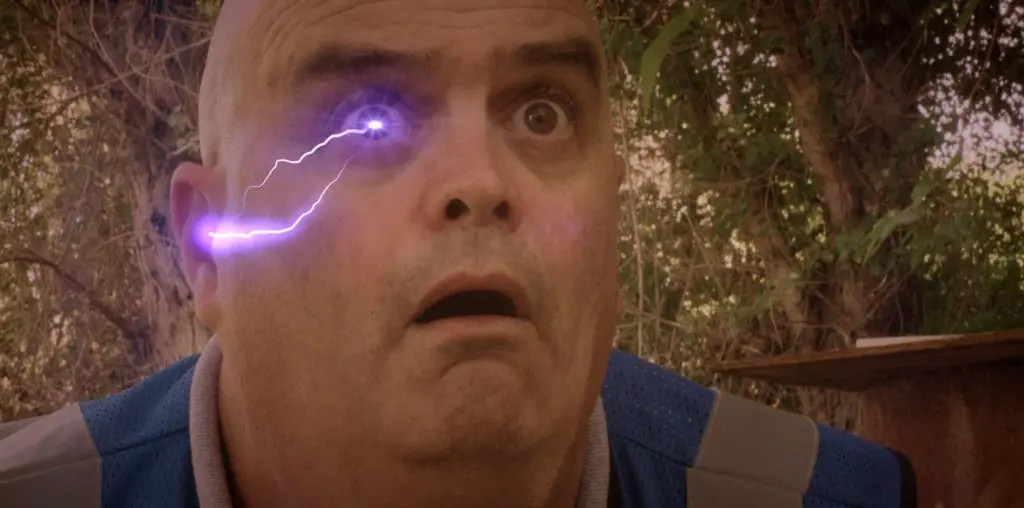
TO HUG YOU AND TO SQUEEZE YOU
This short video constantly intercuts between two sources, a home movie of a wedding ceremony in which the bride and groom are carried aloft on chairs, and clips from an educational film showing otters, bears, and other animals in captivity. The video begins by cutting between the two sources extremely rapidly, almost on every frame. The cuts gradually slow down, reaching a rate of a little more than one second apart by the middle of the video. They then speed up again, ending at the original rate. The wedding shots are in vividly saturated color and the animal clips are black and white. The soundtrack consists of a woman’s voice describing the marriage and breakup of a Western woman to a Muslim Prince, alternating with a male voiceover from the educational nature film. The voices alternate in nearly the same pattern and rhythm as the images, but not identically, so that at times the woman’s voice is mostly heard with the wedding footage, and at times mostly with the animal footage. In the middle, when the cutting is slower and almost full sentences can be heard, several amusing juxtapositions of language can be heard (She: “they just didn’t think in the same way.” He: “gamboling on the green a little lopsidedly came this couple…”).
When the alternations are only one frame apart, it is almost like viewing the two films superimposed. When the alternations are slower, the video functions as a quick-paced comparison between the mating habits of humans and other species. In a brief, amusing and non-didactic way, the video also pokes fun at the whole idea of educational and documentary films, since it demonstrates that you can no more experience nature through a ‘nature film’ than you can understand a relationship by watching a wedding film or by reading a tabloid account of it.
TRIUMPH OF THE PATRIARCH
This video is constructed from a very brief sequence in the film “The Exorcist” in which a man crashes out of a window and tumbles down a long staircase. Kreider has re-edited this sequence via digital video so that the motion ‘rocks’ back and forth, with the man repeatedly rolling part way down the stairs and then back up again. By the end of three minutes, he has gone all the way to the bottom and back up to the window several times. The soundtrack, mainly the crash of glass, seems to roll back and forth exactly in tandem with the images.
The video resembles an extended sequence of video ‘scratching,’ such as a hip-hop DJ might create. To my eye and ear, the rhythms, which Kreider imposes on the footage, are neither musically interesting nor particularly revealing of the inner moments contained within the original sequence. The title hints that the filmmaker intends this editing exercise to be evocative of something or other, but, whatever it is, I wasn’t feeling it. It does, however, reveal the amazing sensation of kinetic upheaval, which director William Friedkin created in just a few frames in the source footage.
HOUSE
This video is made from footage of planks of wood, which are being tossed from a second story window in a building and land on a pile in the back yard. It is another ‘scratching’ video, in which the footage has been digitally manipulated so that it constantly backs up for a few frames and then runs forward again, often in an altered timing. The soundtrack is made up of the crashing of the wood, manipulated to go backwards and forwards exactly as the images do.
In this video, unlike “Triumph of the Patriarch,” I felt that Kreider exhibited a fine sensitivity to the rhythms of the sounds and images. Each time the picture rolled back and forth, it revealed an interesting new aspect of the kinetic properties of falling bodies, exactly how long after impact a piece would start to split apart, how many shards and slivers of wood would rise up, how the shards twisted in the air, how the entire pile would subtly shift, groan and react to each new impact. The coupling of sound and image helped the viewer to experience the kinetic qualities of the falling wood in a more fully physical way. “House” is an entertaining and enlightening study of bodies in motion.
RIPPLE
Soft focus shots of golden light reflecting off of slow motion ripples on a pond, and ducks gliding and waddling in slow motion along the water. Silent.
It took me a while to get over the fact that the visual style of this piece, with it’s golden light, slow cross fades, and clichéd imagery, resembles so strongly a background image you would see in an ad for tampons, long term disability insurance, or an allergy medication. Actually, the images are truly beautiful. The filmmakers highlight the way that patterns on the ducks’ plumage closely resemble the patterns of light on the water. It is a portrait of creatures perfectly evolved to fit into their environment.
COUP D’OEIL
This short, silent video explores tourists as they employ a variety of technologies to capture their experiences. They peer through binoculars, which require a 25-cent deposit, take pictures with instamatics, as well as professional cameras equipped with costly telephoto lenses and tripods, and endlessly videotape the view and each other. The intentness of the tourists and their preoccupation with mastering the technology is quite impressive. At one point, four men seem to be simultaneously photographing each other, as Kreider looks on with his own camera. Surrounded by the sumptuous reality of the Golden Gate Bridge and other sites, beautiful weather, and each other’s companionship, these tourists are completely wrapped up in their quest to consume and own their experiences, rather than simply experiencing them.
